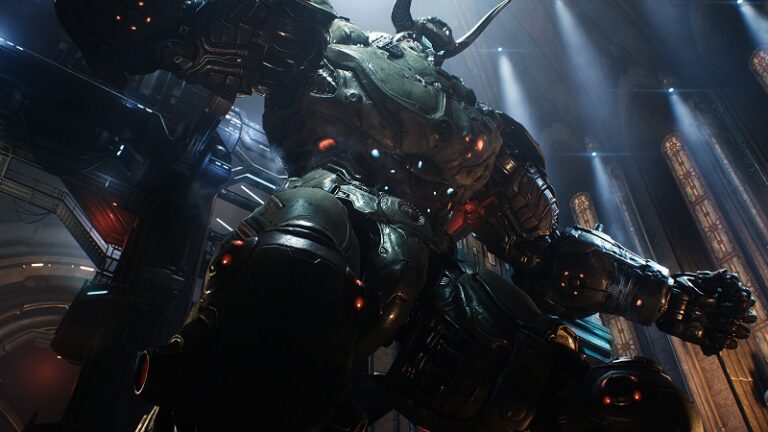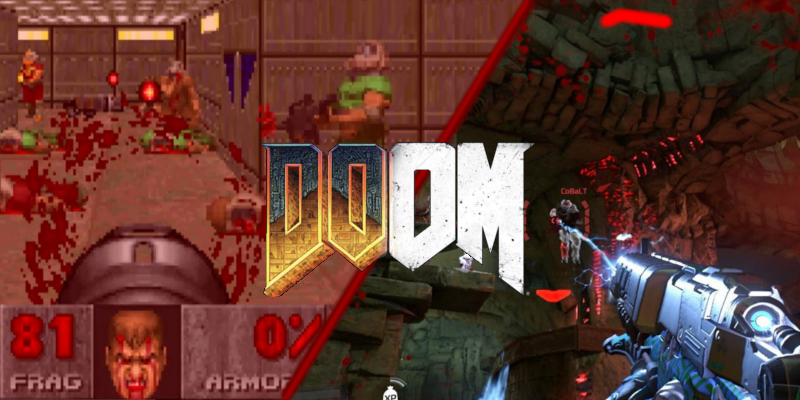
I love Doom. When I heard Id Software were going to make a reboot I was happy, but skeptical. When I saw slow gameplay videos of execution kills and blood covered puzzles I became even more skeptical. The original is a tough act to follow, and the modding scene pushes it further even now; Brutal Doom is still going strong, giving an idea of what can be done with the aging engine. To date, few games match the raw, cathartic bliss of Brutal Doom, and it was clear from the Doom E3 gameplay demo that Bethesda wanted to follow the “Punch Demon in Face” approach. While the E3 demo was by no means bad, I found it failed to excite me. It looked drab, dry, and slow; the weapons seemed a bit wimpy, and the chainsaw seemed to be a cutscene machine … but there was still a spark in there.
I recently played in the Doom Multiplayer Beta. It seemed an odd choice to run with as the figurehead of the title, since demon slaughtering seems to be the star of the show. While it’s no doubt a very different beast to the singleplayer, I still got to try the core of Doom‘s gameplay: the running and the shooting.
It’s…actually kind of fun. Overall, it handles well, though there is a lack of mouse control options that may irk some looking for more fine control in a PC shooter. It looks good, but there’s an overabundance of effects trying to outdo one another, which can be completely overwhelming in chaotic moments. You run round and shoot things with guns, and the guns make things die – eventually.
The weapons are one of my biggest criticisms of Doom so far. While they all go “Bang” in whichever way they feel appropriate, the result is often less than you’d expect. The rocket launcher hits like a water balloon, the heavy assault rifle may eventually tickle foes to death, and the super shotgun kind of just does some damage in the general direction you face. There’s very little feedback, so the disconnect reaches almost MMO levels, so much so that damage values fly off enemies as you hit them. “57!”, it says, triumphantly, as I hit someone dead on with a rocket. “You sure did numbers to that guy!”. The fact that numbers are needed to show that you’ve hit someone is rather telling, especially as enemies take hits without any noticeable reaction, even from explosions. That is, until they actually (and finally) die.
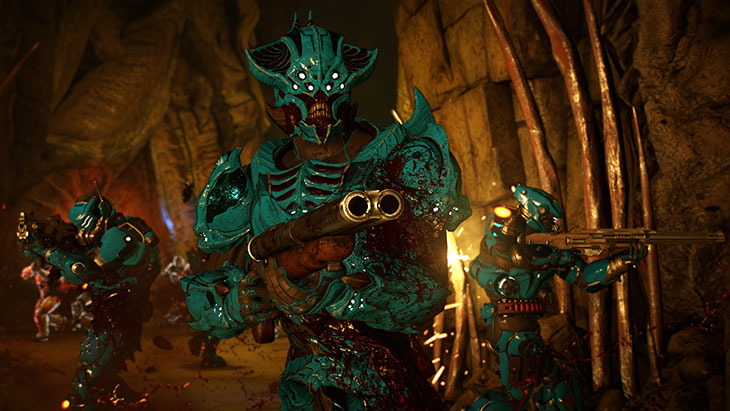
That said, the game can be quite fun. It’s fairly fast paced, even if the player movement is a little on the slow side for an arena shooter, and the combat can be frantic and enjoyable when it gets going. While the levels could benefit from more landmarks to aid navigation through the samey corridors, you find yourself moving around quickly, making good use of terrain to protect yourself, and gathering health and armour to increase survivability quite quickly. Melee is fairly powerful, though, as with other weapons, don’t expect much of a response unless you get a kill. If you do, it’s possible to execute a “glory kill”, an extended special kill that nets you more XP, and is mainly about making sure parts of your target are where they shouldn’t be. Occasionally, a Demon Rune or a powerful heavy weapon will spawn, giving whoever gets it the ability to turn whatever it looks at into paste.
Other than those, there are no weapon pickups, as you’d expect from this kind of shooter. Doom takes a different route.
***
“How do I reload?”, asks a frustrated figure, frantically hammering on the keyboard.
I’ve just introduced a bunch of young gamers to Doom. The original classic shooter, still a favorite in my eyes, earned its place in gaming history through a blend of fast paced violence, the anachronistic mix of sci-fi and demonic horror, and bleeding edge tech that blew anything else out of the water. The first generation of first person shooters were known as “Doom clones” for good reason; it hits hard, hits fast, and delivers an experience so satisfying that it still has a huge community today. It was also the genesis of deathmatch, one of the first to implement networked fragging, much to the delight of its players, and the dismay of network admins. I’ve shown it to the budding developers before me as an example of one of the finest games in existence.
“This is crap. You can’t even jump,” one said.
While some got enjoyment from the aging shooter, the overall atmosphere in the room was hard to read. The core of the game, the feedback, the satisfaction is still there regardless of who plays it, and I could see how it resonated with those who looked for it. Others, weaned on Call of Duty: Subtitle Warfare or Ubisoft Open World Bar Filler Upper 3 had difficulty adjusting to something so simple, streamlined, and perhaps pure?
Modern gamers have different expectations from their shooters these days. The Standard AAA FPS Framework can be seen at work in the majority of big release titles, expanding short form matches into an extensive metagame. Progress is tracked between games, XP bars fill, new things are unlocked, new things are achieved. It can give players something to strive for, keep a community active, and extend the lifespan of a game. It can, however, be very restrictive to new players, tedious to those without the time or inclination to grind for unlocks, and to those that just want access to the features of a game they have paid for, downright insulting. It also, above all else, requires certain concessions to be made in the core gameplay to allow The Framework to function properly. These concessions are, in Bethesda’s Doom, the greatest disappointment.
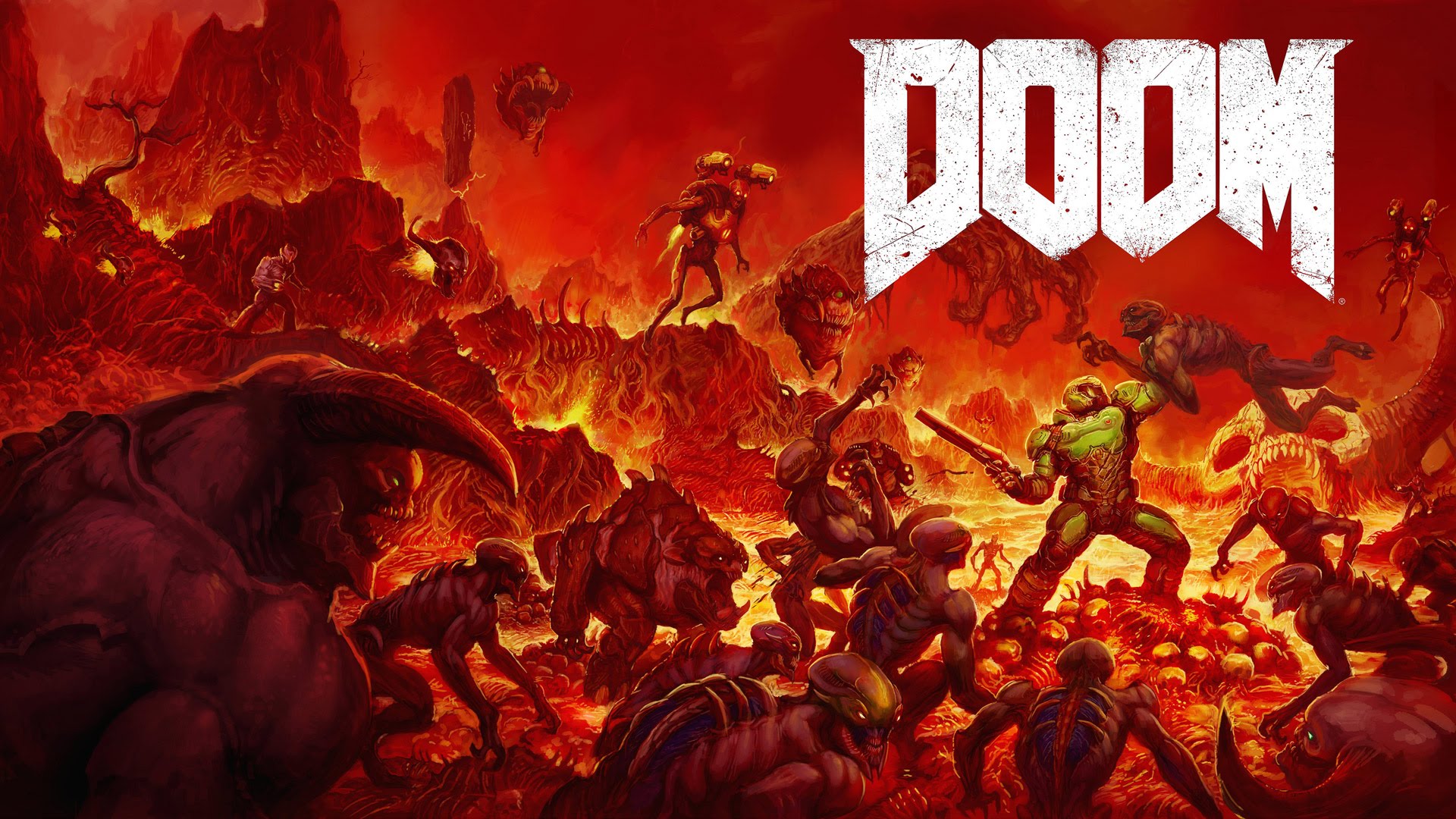
Weapon selection is determined by loadouts. You have access to 3 presets at first, and then can unlock your own as you rank up later on. You pick a set of two weapons to start with, fully geared up. This explains a lot about the weak nature of Doom‘s weaponry. If you can simply choose to start with the rocket launcher, it must be balanced in line with the other weapons. Unfortunately, with everything being so weak, this means it is scaled back significantly.
It’s rare to see an arena shooter move away from weapons as pickups. I’ve seen it work in a few situations, such as Unreal Championship 2, but this type of setup will probably anger purists, as Doom leans more toward contemporary shooters like Call of Duty or Halo.
Gradually, you can unlock other weapons and offhand grenades or gadgets, and add them to your own loadout to choose your own playstyle, though you are still limited to two weapons at a time.
Character customisation is one feature that is always welcomed, and in Doom, you can choose from any number of nauseating colours to clash horribly on your armour and weapons. The default is a very bright red and white getup, and you have a small selection of colours and armour parts to start with. You’ll gradually acquire more as you play matches, but I found it quite difficult to get any that didn’t look bad by default. You can apply weathering and dirt to your character or weapon, which does help a little bit.
There’s also hack modules. When you die, you can activate a hack module, which does…something. Usually some kind of little bonus like seeing your killer through walls, or seeing the spawn timers on superweapons. It’s an interesting concept, but doesn’t seem to have been pulled off particularly well. How exactly you get and apply them is never fully explained, so it can be quite confusing at first, and comes across as a gimmick that doesn’t have much effect on the gameplay, other than to make balancing near impossible. It also hampers competitive play, with a random element being thrown in for players who die. I can imagine high level players may exploit this, risking deliberate deaths for faster bonuses.
Features like these being applied to such a massive and venerable brand as Doom makes me wonder who exactly the target audience is. Gambling the first impressions of the game on multiplayer is a strange move indeed, and the clash of different design philosophies you can see while playing is quite stark. The beta was limited to matchmaking games on two maps, but there is still a possibility we may see custom or dedicated servers, and with them more control over gameplay. A Classic mode without all the level up nonsense would be a feature I’d like to see.
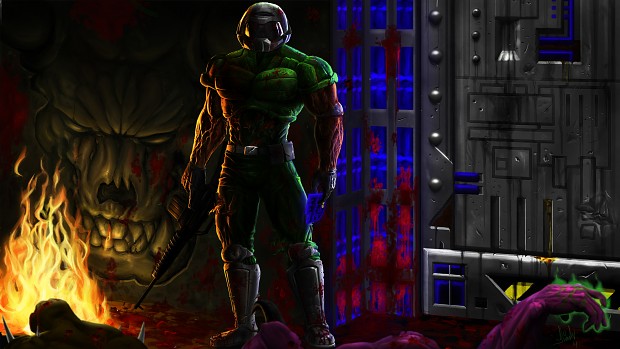
All that said, there’s a good chance if you’re reading this here, you’re not interested in the multiplayer at all, and are more interested in killing demons. There’s enough of a solid core in there for it to be enjoyable, but gunplay feels sluggish and unsatisfying. Veterans will likely be disappointed by just how different from the original it is, but it’s unrealistic to think it wouldn’t have some significant changes to bring it in line with modern expectations. How the final game ends up as a singleplayer horror shooter remains to be seen, but without enough flair or features to give it a personality of its own, I doubt I’ll be revisiting the multiplayer anytime soon.

 TheSnee
TheSnee
